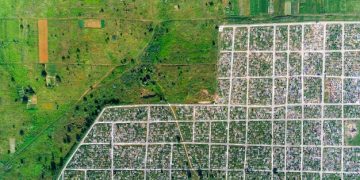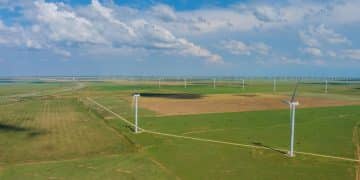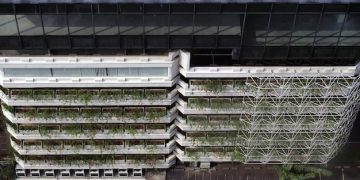Sustainable Agriculture: New Farming Practices for Climate Change Mitigation in the US
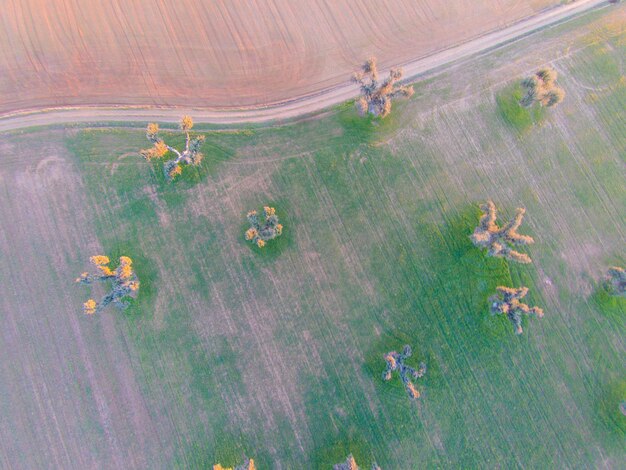
Sustainable agriculture in the US is evolving with new farming practices like cover cropping, no-till farming, and agroforestry, which enhance carbon sequestration, reduce greenhouse gas emissions, and promote biodiversity to mitigate climate change.
The agricultural sector in the United States is a significant contributor to greenhouse gas emissions. However, innovative and **sustainable agriculture** practices offer a viable path toward mitigating climate change. These new farming methods not only reduce the environmental impact of agriculture but also enhance the resilience and productivity of farms across the US.
What is Sustainable Agriculture?
Sustainable agriculture integrates three main goals—environmental health, economic profitability, and social and economic equity. It’s a system of farming that aims to meet current food and textile needs without compromising the ability of future generations to meet their own needs.
In the context of climate change, sustainable agriculture seeks to minimize greenhouse gas emissions from farming activities and enhance the capacity of agricultural lands to act as carbon sinks.
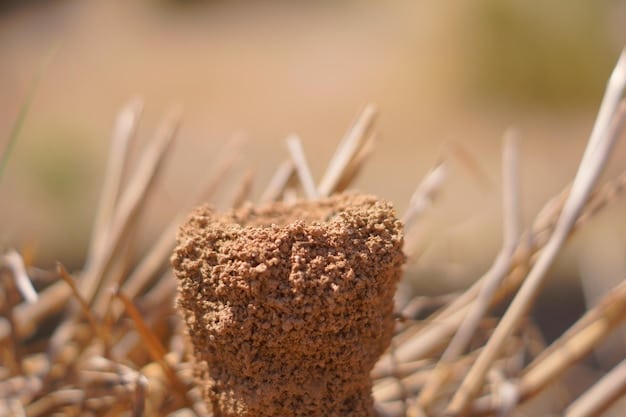
Cover Cropping: Enhancing Soil Health and Carbon Sequestration
Cover cropping involves planting specific crops primarily to benefit the soil, rather than for harvest. These crops, such as legumes, grasses, and brassicas, offer multiple benefits.
Cover crops improve soil structure, increase water infiltration, and reduce soil erosion. They also play a crucial role in carbon sequestration, storing atmospheric carbon in the soil. Here are some of the benefits of cover cropping:
Benefits of Cover Cropping
- Improved Soil Health: Cover crops add organic matter to the soil, enhancing its structure and fertility.
- Reduced Erosion: The dense root systems of cover crops protect the soil from wind and water erosion.
- Carbon Sequestration: Cover crops capture atmospheric carbon and store it in the soil.
- Weed Suppression: Certain cover crops can suppress weed growth, reducing the need for herbicides.
Farmers across the US are increasingly adopting cover cropping as a sustainable practice. Federal and state programs often provide financial incentives to encourage its use.
Cover cropping not only benefits the environment but also enhances long-term soil productivity, leading to more sustainable and resilient farming systems.
No-Till Farming: Reducing Emissions and Conserving Soil
No-till farming is a conservation practice that eliminates plowing and tilling of the soil. This minimal disturbance approach has significant environmental benefits.
No-till farming reduces soil erosion, conserves water, and improves soil health. More importantly, it minimizes the release of carbon dioxide from the soil, contributing to climate change mitigation. Here’s how no-till farming works:
No-Till Farming Practices
- Direct Seeding: Seeds are planted directly into the soil without prior tillage.
- Residue Management: Crop residue is left on the soil surface to protect it from erosion and conserve moisture.
- Reduced Soil Disturbance: Minimal soil disturbance helps maintain soil structure and reduce carbon emissions.
Many US farmers are transitioning to no-till farming, supported by technological advancements in planting equipment and herbicide application. This transition helps reduce fuel consumption and labor costs, making it an economically viable option as well.
No-till farming is a cornerstone of sustainable agriculture, offering a practical and effective way to mitigate climate change while improving farm productivity.
Agroforestry: Integrating Trees into Farming Systems
Agroforestry combines agriculture and forestry practices to create more integrated and sustainable land-use systems. It involves intentionally integrating trees and shrubs into crop and animal farming systems.
Agroforestry practices can improve soil health, enhance biodiversity, and increase carbon sequestration. They also provide additional income streams for farmers through the sale of timber, fruits, and nuts. Examples include:
Types of Agroforestry Systems
- Alley Cropping: Planting crops in alleys between rows of trees or shrubs.
- Silvopasture: Integrating trees and livestock grazing on the same land.
- Windbreaks: Planting rows of trees to protect crops and livestock from wind.
Agroforestry is gaining popularity in the US, with farmers recognizing its potential to enhance farm resilience and profitability. Government programs and research initiatives are supporting its adoption across different regions.
By integrating trees into farming systems, agroforestry offers a holistic approach to sustainable agriculture, addressing both economic and environmental concerns.
Precision Agriculture: Optimizing Resource Use
Precision agriculture uses technology to optimize resource use in farming. It involves using sensors, GPS, and data analytics to monitor and manage inputs such as water, fertilizers, and pesticides more efficiently.
Precision agriculture reduces waste, lowers input costs, and minimizes the environmental impact of farming. It also helps farmers make more informed decisions, leading to increased yields and profitability. Benefits include:
Advantages of Precision Agriculture
Precision agriculture has many benefits including:
- Efficient Water Use: Precision irrigation systems deliver water only where and when it is needed.
- Optimized Fertilizer Application: Variable rate fertilizer application ensures that crops receive the right amount of nutrients.
- Reduced Pesticide Use: Targeted pesticide application minimizes the use of chemicals.
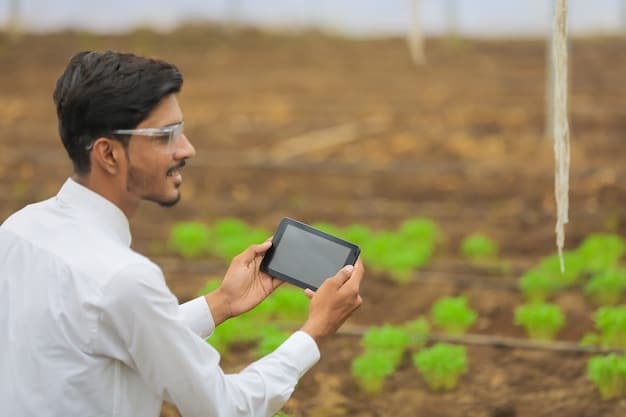
Many US farms are adopting precision agriculture technologies, driven by advancements in sensor technology, data analytics, and automation. This technology is supported by federal and state initiatives aimed at promoting innovation in agriculture.
Precision agriculture is a key component of sustainable farming, helping farmers optimize resource use and minimize their environmental footprint.
Reduced Fertilizer Use: Minimizing Greenhouse Gas Emissions
Excessive use of synthetic nitrogen fertilizers is a major source of greenhouse gas emissions in agriculture. Nitrogen fertilizers release nitrous oxide, a potent greenhouse gas, into the atmosphere.
Reducing fertilizer use can significantly lower greenhouse gas emissions. Strategies include:
- Using Nitrogen-Fixing Crops: Integrating legumes into crop rotations to naturally fix nitrogen in the soil.
- Applying Slow-Release Fertilizers: Using fertilizers that release nutrients gradually over time.
- Optimizing Fertilizer Application: Applying fertilizers at the right time and in the right amount.
Farmers are increasingly adopting practices to reduce fertilizer use, driven by environmental concerns and economic incentives. Government programs and research initiatives are supporting the development and adoption of more efficient fertilizer management practices.
Reducing fertilizer use is a vital step toward making agriculture more sustainable and mitigating its impact on climate change.
Sustainable Livestock Management: Reducing Methane Emissions
Livestock production is a significant source of methane, a powerful greenhouse gas. Enteric fermentation, the digestive process in ruminant animals like cattle, produces methane as a byproduct.
Sustainable livestock management practices can help reduce methane emissions. These practices include:
- Improving Feed Efficiency: Providing livestock with high-quality feed to improve digestion and reduce methane production.
- Using Feed Additives: Supplementing livestock diets with additives that inhibit methane production.
- Implementing Rotational Grazing: Managing grazing lands to improve forage quality and reduce methane emissions.
Many US livestock producers are adopting sustainable management practices, driven by environmental concerns and consumer demand for more sustainable products. Policies and incentives are supporting the adoption of these practices.
Sustainable livestock management is crucial for reducing greenhouse gas emissions and promoting a more environmentally friendly agricultural sector.
| Key Concept | Brief Description |
|---|---|
| 🌱 Cover Cropping | Planting crops to improve soil health and sequester carbon. |
| 🚜 No-Till Farming | Eliminating plowing to reduce erosion and carbon emissions. |
| 🌳 Agroforestry | Integrating trees into farming systems for multiple benefits. |
| 🐄 Sustainable Livestock | Managing livestock to reduce methane emissions. |
Frequently Asked Questions
▼
Sustainable agriculture improves environmental health, boosts economic profitability for farmers, and promotes social equity by ensuring food security and supporting rural communities.
▼
Cover cropping enhances carbon sequestration by capturing atmospheric carbon and storing it in the soil, improving soil health and reducing erosion, which contributes to climate change mitigation.
▼
No-till farming involves planting crops without plowing or tilling the soil. It reduces soil erosion, conserves water, and minimizes carbon dioxide release, making it crucial for climate change mitigation.
▼
Precision agriculture uses technology like sensors and data analytics to efficiently manage inputs like water, fertilizers, and pesticides, reducing waste and minimizing the environmental impact of farming.
▼
Improving feed efficiency, using feed additives, and implementing rotational grazing can significantly reduce methane emissions from livestock, making livestock management more sustainable and eco-friendly.
Conclusion
Adopting **sustainable agriculture** practices in the US is essential for mitigating climate change and ensuring long-term food security. By embracing innovative techniques like cover cropping, no-till farming, agroforestry, precision agriculture, and sustainable livestock management, farmers can reduce greenhouse gas emissions, enhance soil health, and build more resilient and productive farming systems.

